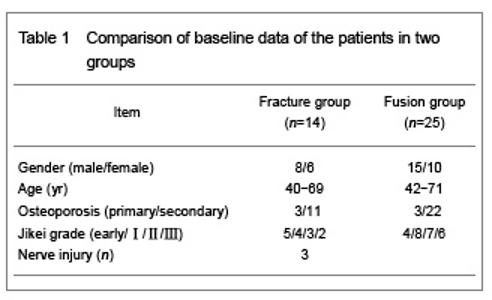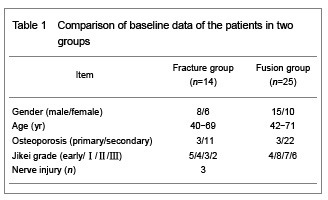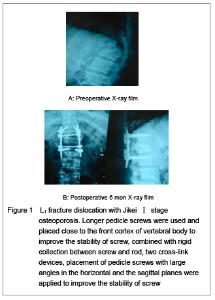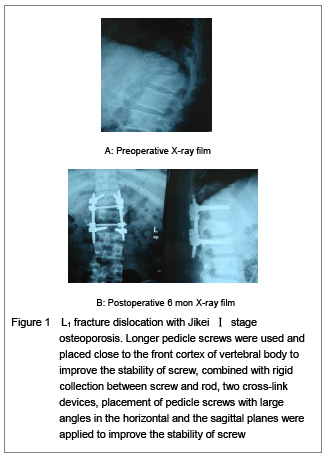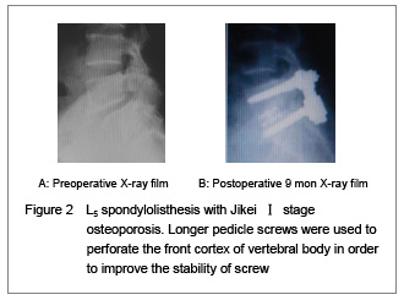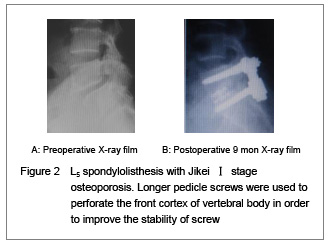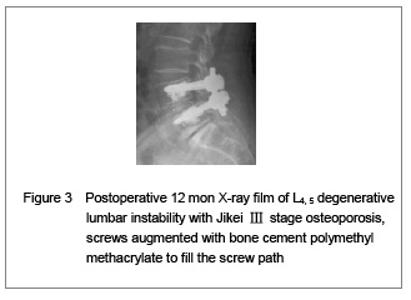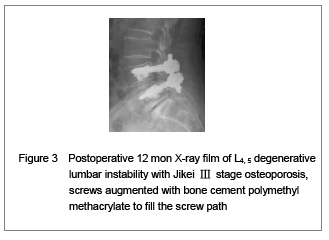| [1] Zhou ZH, Cheng L, Yin QD. Research progress in stability of pedicle screw.Zhongguo Zuzhi Gongcheng Yanjiu yu Linchuang Kangfu. 2011;15(26):4872-4875.[2] Amendola L, Gasbarrini A, Fosco M, et al. Fenestrated pedicle screws for cement-augmented purchase in patients with bone softening: a review of 21 cases. J Orthop Traumatol. 2011;12(4):193-199.[3] Paré PE, Chappuis JL, Rampersaud R, et al. Biomechanical evaluation of a novel fenestrated pedicle screw augmented with bone cement in osteoporotic spines.Spine (Phila Pa 1976). 2011;36(18):E1210-E1214.[4] Soshi S, Shiba R, Kondo H, et al. An experimental study on transpedicular screw fixation in relation to osteoporosis of the lumbar spine.Spine (Phila Pa 1976). 1991;16(11):1335-1341.[5] Weinstein JN, Rydevik BL, Rauschning W. Anatomic and technical considerations of pedicle screw fixation. Clin Orthop Relat Res. 1992;(284):34-46.[6] Polly DW Jr, Orchowski JR, Ellenbogen RG. Revision pedicle screws. Bigger, longer shims--what is best. Spine (Phila Pa 1976). 1998;23(12):1374-1379.[7] Weng XS,Qiu GX,Zhao WD, et al. Biomechanical study of various pedicle screw revision techniques. Zhonghua Guke Zazhi. 2003;23(10):622-626.[8] Frankel BM, Jones T, Wang C. Segmental polymethylmethacrylate-augmented pedicle screw fixation in patients with bone softening caused by osteoporosis and metastatic tumor involvement: a clinical evaluation. Neurosurgery. 2007;61(3):531-537.[9] Yin QD, Zheng ZG, Cai JP. Applied anatomy and mechanical test for placement of screw of pedicle-rib unit in the thoracic spine. Zhongguo Linchuang Jiepouxue Zazhi. 2005;23(5):538-539.[10] Moon BJ, Cho BY, Choi EY, et al. Polymethylmethacrylate- augmented screw fixation for stabilization of the osteoporotic spine: a three-year follow-up of 37 patients. J Korean Neurosurg Soc. 2009;46(4):305-311.[11] Becker S, Chavanne A, Spitaler R, et al. Assessment of different screw augmentation techniques and screw designs in osteoporotic spines. Eur Spine J. 2008;17(11): 1462-1469.[12] Bullmann V, Liljenqvist UR, Rödl R, et al. Pedicle screw augmentation from a biomechanical perspective. Orthopade. 2010;39(7):673-678.[13] Yin QD, Zheng ZG, Cai JP, et al. An in vitro biomechanical study of the relative stability of pedicle screw. Jiangsu Yiyao. 2005;31(2):119-121.[14] Ding Y, Ruan DK, Huang WH, et al. Biomechanical evaluation of cross-link device in pedicle screw systems. Zhongguo Linchuang Jiepouxue Zazhi. 2002;20(6): 466-468.[15] Zhang GL, Li N, Gong MQ, et al. Characteristics of pedicle screw fixation for thoracolumbar burst fractures among middle and old aged patients. Zhonghua Guke Zazhi. 2002; 22(12):727-731.[16] Heyde CE, Rohlmann A, Weber U, et al. Stabilization of the osteoporotic spine from a biomechanical viewpoint. Orthopade. 2010;39(4):407-416. |
